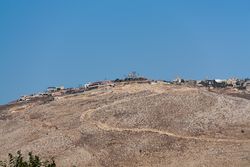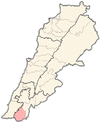مارون الراس
مارون الراس
Maroun al-Rass | |
|---|---|
قرية | |
 قرية مارون الراس، كما تبدو من الجانب الإسرائيلي للحدود، بالقرب من أڤيڤيم | |
| الإحداثيات: 33°04′50″N 35°25′20″E / 33.08056°N 35.42222°ECoordinates: 33°04′50″N 35°25′20″E / 33.08056°N 35.42222°E | |
| موقع الجريدة | 191/278 PAL |
| البلد | |
| المحافظة | محافظة النبطية |
| القضاء | قضاء بنت جبيل |
| المنسوب | 945 m (3٬100 ft) |
| منطقة التوقيت | UTC+2 (EET) |
| • الصيف (التوقيت الصيفي) | UTC+3 (EEST) |
| Dialing code | +961(7) |
مارون الراس هي احدى القرى اللبنانية من قرى قضاء بنت جبيل في محافظة النبطية. وتقع على بعد 120 كم جنوب شرق بيروت، على بعد نحو كيلومتر واحد من الحدود مع إسرائيل.
. . . . . . . . . . . . . . . . . . . . . . . . . . . . . . . . . . . . . . . . . . . . . . . . . . . . . . . . . . . . . . . . . . . . . . . . . . . . . . . . . . . . . . . . . . . . . . . . . . . . . . . . . . . . . . . . . . . . . . . . . . . . . . . . . . . . . . . . . . . . . . . . . . . . . . . . . . . . . . . . . . . . . . . .
التاريخ
In 1596, it was named as a village, Marun er-Ras, in the Ottoman nahiya (subdistrict) of تبنين under the liwa' (district) of Safad, with a population of 97 Muslim households. The villagers paid a fixed tax of 25% on agricultural products, such as wheat, barley, olive trees, vineyards, goats and beehives, in addition to "occasional revenues" and an olive oil press; a total of 8,960 akçe.[1][2]
In 1838 Edward Robinson noted it as a village located on a higher hill than Yarun.[3]
In 1881, the PEF's Survey of Western Palestine (SWP) described it: "A stone village, with some large stones built into walls, containing about 150 Moslems, situated on the top of high hills, with vineyards and arable land; water is obtained from 'Ain Hara, and cisterns in the village."[4] They further noted: "At this village there are a considerable number of well-cut stones and remains, which indicate that there was once a church here similar to that at Yarun; these stones have been mostly found to the west of the village, in vineyards. A capital of a column, with mediaeval ornamentation, and a small piece of sculptured stone, with leaves and figures as at Yarun, are in the village. There is also an architrave with a Greek inscription, in three pieces."[5]
In the 1945 statistics the population was counted with Saliha and Yaroun, and totalled 1070 Muslims[6] with 11,735 dunams of land, according to an official land and population survey.[7] Of this, 7,401 dunams were allocated to cereals, 422 dunams were irrigated or used for orchards,[8] while 58 dunams were built-up (urban) area.[9]
الحرب الأهلية اللبنانية
On March 1, 1978 the village was occupied by a force of 60 Phalangists, drawn from the villages around Ain Ebel, at the behest of the Israeli military and led to believe by Israeli advisors that they would be welcomed with open arms by the inhabitants. The Phalangists had received vague promises of air support from Israel should they be met with resistance, which they never received. Seven Phalangists were killed when Fatah militants and their allied of the Lebanese National Movement arrived, and the rest of the phalangists had to flee. Israeli troops remained in Ain Ebel until Israel's invasion of Lebanon two weeks later.[10]
حرب لبنان 2006
The village was the scene of a major confrontation between the Israeli Army and Hezbollah fighters during the 2006 Lebanon War.[11]
Maroun el-Ras is strategically important as it overlooks the surrounding towns. The village's elevation is 911 meters (2,989 feet).
During the Battle of Maroun al-Ras of the 2006 Lebanon War, the village was partly occupied by Israel, which claimed it was a stronghold for Hezbollah and one of the launching points for rocket attacks on northern Israel.[12]
There are reports that control of the village was contested at the time of the ceasefire. After-battle reports claimed the IDF troops never fully secured the border area and that Maroun el-Ras was never fully taken.[13][14]
مرئيات
| حزب الله ينصب تمثالاً لقاسم سليماني، في مارون الراس، على الحدود الإسرائيلية اللبنانية، فبراير 2020. |
المراجع
- ^ Hütteroth and Abdulfattah, 1977, p. 181
- ^ Note that Rhode, 1979, p. 6 writes that the register that Hütteroth and Abdulfattah studied was not from 1595/6, but from 1548/9
- ^ Robinson and Smith, 1841, vol 3, p. 371
- ^ Conder and Kitchener, 1881, SWP I, p. 202
- ^ Conder and Kitchener, 1881, SWP I, p. 251
- ^ Department of Statistics, 1945, p. 11
- ^ Government of Palestine, Department of Statistics. Village Statistics, April, 1945. Quoted in Hadawi, 1970, p. 71
- ^ Government of Palestine, Department of Statistics. Village Statistics, April, 1945. Quoted in Hadawi, 1970, p. 121
- ^ Government of Palestine, Department of Statistics. Village Statistics, April, 1945. Quoted in Hadawi, 1970, p. 171
- ^ Tveit, Odd Karsten (1985). Nederlag. Israels krig i Libanon (in Norwegian). Cappelen. pp. 50–52. ISBN 82-02-09346-5.
{{cite book}}: CS1 maint: unrecognized language (link) - ^ Israel Enters Southern Lebanon - Hits Maroun al-Ras and Yaroun Villages :: Middle East News and Perspectives :: Hyscience
- ^ http://sg.news.yahoo.com/060722/3/429gv.html[dead link]
- ^ Asia Times HOW HEZBOLLAH DEFEATED ISRAEL-PART 2: Winning the ground war
- ^ "Timesonline August 27, 2006 Humbling of the supertroops shatters Israeli army morale". Archived from the original on 2016-09-13. Retrieved 2016-08-09.
| هل أنت مهتم ببلد الأرز لبنان ؟ ستجد الكثير من المعلومات عنه في بوابة لبنان. |


